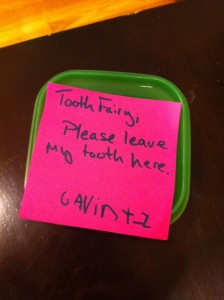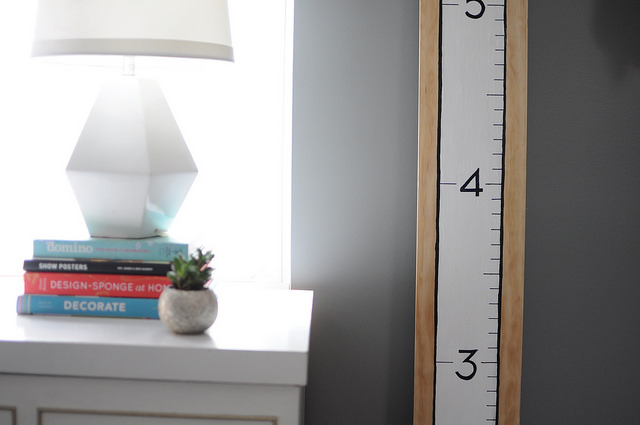If you’re short on attention, pictures at bottom
Have you ever found it odd that we tell our kids a fairy tale about someone who breaks into the house in the middle of night and steals teeth from under their pillows while we are sleeping? If you have, you’re like my 6 year old who lost his first tooth today.
Like many of us, he processes the events of the day as goes to sleep. And apparently the horror of the whole mafia-like forced-to-sell situation didn’t dawn on him until about 10 minutes after bedtime.
Enough time had passed that I thought he was fast asleep, and I was browsing reddit in my room on the other side of the house. Our downstairs neighbors just had a baby, so when I heard muffled crying I assumed it was, per usual, the downstairs infant.
After a minute or so, as I sat judging the poor parenting of my neighbors who would let their child cry for so long, I noticed a familiar tone to the whelps and realized it was my own son. (As an aside in my defense, he is now six, so crying doesn’t happen that often… and, there were some particularly interesting cat pictures on Reddit tonight…)
I arrive in my son’s room to find him sitting up on his bed, having completely covered himself in his blanked as a protective cave, crying like he was powerless to stop something he loved from being destroyed.
I sit down and start to comfort him and this is when we began our usual game of “wait wait, what’s wrong… yes, no, I don’t want to tell you.” It’s not a game I particularly like, but he insists on playing and can’t be persuaded otherwise.
Dad: “Did you get hurt?
Blanket cave shakes side to side… I think that’s a no.
Dad: “Did your stuffed dog get hurt?”
Blanket cave shakes side to side… no chuckle at the stupidity of the question… bad sign…
Dad: “Do you miss Mommy (who is out getting dinner with a friend)?”
Blanket cave shakes side to side.
Dad: “Are you scared of something?”
Short pause, blanket cave shakes side to side… maybe there’s something there.
The peak of blanket cave mountain is lain upon my lap for comfort.
The crying subsides to a soft whimper and a sniffle. A hand extends from blanket cave and points to the floor, then the window.
This is real progress! I have absolutely.no.idea. what pointing at the floor then the window could mean, but the blanket cave is attempting to communicate!
Dad: “Did something fall down and break?”
Blanket cave sniffles, shakes side to side, then a child emerges, shuffles to the floor, points morosely to his colored pencil box, then to the window, and quickly re enters blanked cave.
This is the worst game of charades I have ever played.
Now, you have to imagine my puzzlement at this point. You as the reader have the benefit of knowing that this is a story about the tooth fairy, and even with that advantage I’d bet that you’re having trouble figuring out what a colored pencil box and a window ledge have to do with dental-larceny. I was clueless, and Gavin was still crying.
After a few more rounds of guessing, and some comforting, he saw that I didn’t get it and shuffled to the floor to get his pencil box.
Dad: “Did one of your pencils break?”
Child: “No”
Another major victory, we’ve established verbal communications!
Dad: “What’s wrong?”
Child: Opens pencil box, points to the middle, starts to mist up again, and manages a meek “my tooth.”
Dad: “What’s wrong with your tooth?”
At this point I see that he has hidden his tooth in the pencil box. That’s a really great, if somewhat perplexing, hiding spot for a tooth.
Child: “I don’t want the tooth fairy to take it.” Full cry returns.
Usually epiphanies are great. Finally seeing the pieces and how they fit together is usually an exhilarating feeling. Not this time. Sudden clarity that a pointless lie is causing substantial distress for your child is a horrible feeling.
I go along with Santa because I can see how much joy he gets from the ruse. But this, this tiny imaginary winged woman stealing my kids stuff and making him cry, that’s not ok. What does she even do with the teeth once she gets them? This is suspicious behavior to say the least and I for one think we should contact TLC or the Easter Bunny about an intervention…
Dad: “Its ok honey, she doesn’t have to take it.”
Child: “But she needs them for her magic.”
This is the point where I get a bit mad. F everything about this. Who the *#@#$ @#$@# is feeding my kid these elaborate lies?
I briefly consider going full truth. If you’ve ever tried to tell a tired, distraught child that they’ve been lied to and tricked, please let me know how that went. He was still whimpering, and I couldn’t bring myself to make the world less magical on top of everything else he was dealing with.
So, I enter a phase known to anyone ever almost caught in a lie; I try to extend the lie.
“She doesn’t always need them for magic” “What about a paper tooth” “She can take it later if you want” “She gets lots of teeth, she doesn’t need yours if you want to keep it” “We can just write her a note”
Finally, the catch in his breath tells me he thinks something in what I’ve just said might work. I see him looking at a stack of post-it notes… He’s processing how the note thing might work.
I start processing how the note thing might work — where do we leave this note, what does it say, we can’t leave it on the front door because we don’t know where she intends to break in, how do we even know she reads English?
I look at his stack of multi colored post it notes, the small Tupperware container the tooth, and the aforementioned colored pencil box, and I suddenly think I’m parenting-freaking-macguiever, and I might be able to defuse this bomb.
Dad: “OK, we can write her a note, we’ll just say ‘please don’t take my tooth'”
Child: lip still quivering slightly, “You write it”
Dad: “OK”
Child: “I’ll sign it, so she knows its from me”
Crayola pencil and pink post it note in hand, I start writing a note to the tooth fairy.
Tooth Fairy,
Please leave my tooth here.
Child signs his name in the most adorable mixed case.
We put the post-it note on top of the case, put the case in the window (apparently he’s been told that tooth fairies use windows when they decide to break-and-enter), and his crying stops.
He asks for and gets another story and finally goes back to sleep.
A few pictures of the anti-dental-theft apparatus we rigged up:

Tooth Fairy Anti Larceny: Exhibit A

Tooth Fairy Anti Larceny Note: Exhibit B



